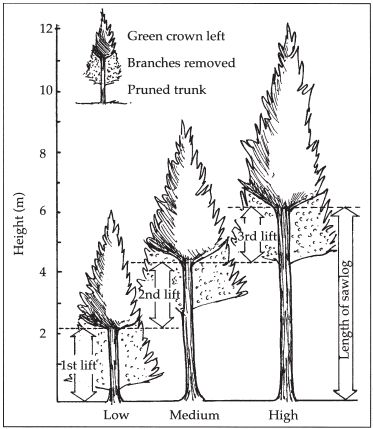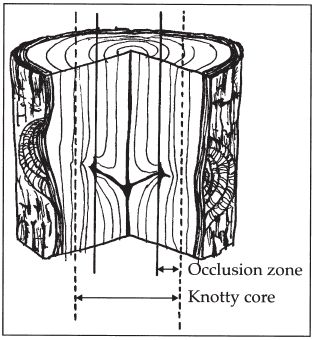Pruning
NZFFA Information leaflet No. 7 (2005).
Although in NZ we normally think of pruning in terms of producing clearwood, there are a number of other reasons for pruning.
- Stability pruning
- Form pruning
- Pre-emptive pruning
- Access pruning
- Clear pruning
- Pruning height
- Pruning intensity
- Defect core size
Stability pruning
This is normally carried out in plantations between the ages of 1 and 3 that are liable to topple in strong winds or be damaged by snow. Trees in this age range often have relatively weak root systems (particularly radiata of high GF rating), and are easily toppled in wet conditions if planted on clay soils with poor cohesion, or if the top has outgrown the roots on moist fertile sites, or if heavy and/or steep-angled whorls of branches promote the lodging of snow. Pruning can be carried out with secateurs, and should aim to remove or shorten back branches in the middle to upper crown to reduce the leverage caused by wind resistance. Where snow damage is a problem, heavy whorls of branches should be thinned to reduce the opportunity for snow to lodge.
Where stability pruning is likely to be necessary, it should be employed as a preventative measure rather than a curative measure. Where toppling occurs after age 3 or 4, this is likely to be due to poor drainage, shallow soils, inadequate site preparation, poor planting, poor tree stocks, or some combination of these factors, and stability pruning at this stage is unlikely to have any lasting effect.
Form pruning
This is aimed at retaining or creating trees with a single dominant leader and a straight stem. Forks and ramicorns should be removed as soon as they can be identified, and any laterals likely to compete with the leader should be removed or trimmed back. Where the leader has already been lost or irreversibly deformed, the lateral best placed to take over (usually on the windward side in districts with a predominant wind) should be encouraged to take over as soon as possible, by removing competing laterals. This operation is best carried out in mid-summer, when retarded leaders and likely replacements become obvious.
If form pruning is carried out early and regularly, most seedlings can be turned into satisfactory final crop trees unless they have been poorly planted or are genetic runts. Thus, where survival after planting has been poor, a final crop can often still be salvaged with timely form pruning.
Pre-emptive pruning
This is an extension of form pruning that aims to remove in advance, those branches that are most likely to cause problems at the time of clear pruning. In particular, it involves thinning out potentially heavy whorls (‘basket whorls’) by removing up to half the branches as early as possible, and removing particularly coarse branches, especially those that are likely to be more than about 3cm in diameter at the time of the next visit.
As with form pruning, early and regular pre-emptive pruning requires little effort and is particularly useful in dealing with multi-branched species with a wide range of branch sizes, such as macrocarpa and Douglas-fir. As a general rule, straight grained timber is not produced over branch stubs until the stem diameter is six times the diameter of the largest branch in a pruned whorl, so removing large branches early, can minimise the knotty core.
Access pruning
This normally involves clear pruning all stems to a height of 1.8 to 2m to provide ready access to the stand for inspection, measurement or thinning, to provide good visibility to allow stock mustering where grazing is carried out, and to act as a fire control measure, preventing ground fires from spreading to crowns and allowing good access for fire-fighters. It is normally only done in stands which are not to be clear-pruned, and it is often delayed until the branches to be removed are moribund or dead.
Clear pruning
This involves pruning off all branches so that all subsequent diameter growth of the stem produces wood free of knots. Thus it has to be a compromise between producing the maximum amount of clear timber (smallest defect core) and not stunting the trees by removing too much active foliage.
In the past, fixed-lift pruning was the norm. With this method, all trees are pruned to the same height at the same time, say to 2.4, 4.5 and 6m, but small trees are more severely affected (over pruned) than large ones. Where there is significant variation within a stand in the height of trees to be pruned, a better alternative is variable-lift pruning, where severity of pruning can be controlled in one of three ways:
- Proportion of height. Trees are pruned so that the length of green crown left is a fixed proportion (say 50%) of total tree height. Without measuring height, this is a difficult parameter to measure by eye when standing beneath the tree.
- Length of green crown. Trees are pruned to leave a certain minimum length of green crown (say 4m). This tends to favour the smaller trees, but again, the length of green crown is difficult to estimate by eye from the ground.
- Gauge pruning. Trees are pruned to the internode which is at or just less than a given diameter (say 10cm). This method is relatively easy to apply, especially if the pruners carry a simple U-shaped gauge to measure diameter. It has the advantage that diameter is directly correlated with cross-sectional area, which in turn is directly correlated with the amount of foliage above that point on the stem. Thus all trees have much the same amount of foliage left, but small trees tend to be favoured slightly because they have less biomass to support.
Pruning height

Depending upon growth rates and rotation ages, there is an upper limit beyond which it is not economic to prune. As most of the value of a tree is in the lower and fatter part of the trunk, pruning is normally carried out on the bottom log only, which in this country is usually taken as 5.5 to 6m. When dealing with valuable timbers (hardwoods, veneer logs), a pruned log length of 3m may be acceptable, and on exposed sites, pruning beyond 3 or 4m may not be economic. On fertile agroforestry sites, extra high pruning above 6m may be desirable not only to produce clear timber and minimise logs with heavy branches, but also to minimise shading of the pasture.
Pruning intensity
The aim of clear pruning is to restrict the size of the knotty core as far as possible without unnecessarily affecting the growth of the tree. Healthy trees usually carry more foliage than they need, so a light pruning has no effect on growth, and the foliage removed is quickly replaced. Moderately heavy pruning affects diameter growth, but severe pruning (removing >50% of the active foliage) can also stunt height growth. Thus to have least effect on growth, pruning should be a little and often. This has the added benefit of minimising the size of the knotty core (Think of pruning like humans donating blood – a little and often does us no harm at all, but the occasional heavy loss can seriously affect our health!).
As most logs are cut parallel to the pith, ideally the defect core should be a perfect cylinder. In practice however, most pruning in the past has tended to produce a defect core which is smallest near the base of the log, and largest near the top. This is particularly so with farm foresters, who are often keen to start low pruning as soon as possible, but are often lax in getting the final pruning done in good time.
On dry or exposed sites, or wherever height growth is depressed, if too small a knotty core is aimed for, height growth will be further restricted, and if stem crowding is not a factor, the lowest remaining whorl of branches, which has first call on available stem moisture, will soon become massive as the tree tries to replace its foliage. If this whorl is removed before the branches become too large, height growth will be even more restricted. On such sites then, either a larger knotty core should be the aim, or size of branches should be controlled by higher stockings.
Defect core size

The defect core in a log is the straight-sided cylinder or truncated cone which encloses all defects, and outside which it is possible to cut full length clear timber. Its size is determined by the radius of the longest branch stubs, the extra radius required before clearwood is laid down beyond the stub, and the straightness of the pith. Shorter lengths of clearwood may be produced between branches, both in a vertical plane and in a tangential plane, but the normal aim of pruning is to produce clearwood in lengths as long as possible.
The effective diameter of the knotty core is determined by the largest diameter over stubs (DOS) after any pruning operation, and this is normally the diameter over the lowest whorl or lowest branch removed in that pruning operation.
With variable-lift pruning then, the more often pruning is carried out, the smaller the DOS. For radiata, the normal range to aim for is 14 to 18cm, but this can be unrealistically low on exposed sites or wherever height growth is limited.
The extra radius to occlude branch stubs is determined by the diameter of the stub and the species of tree. Therefore pruning branches while they are still small will minimise the occlusion zone. The straightness of the pith depends on how straight the tree was at the time of pruning (not on the straightness of the harvested log).
The defect core is normally several cm wider than the knotty core for perfectly straight trees, and considerably wider for trees which are sinuous at the time of pruning. Therefore, to maximise clearwood production, prune often, aim for the same DOS with each pruning lift, keep the DOS to a minimum consistent with maintaining an acceptable growth rate, and place high priority on pruning only the straightest trees.
Graphics reproduced from Managing a Small Forest for Timber – no.6 in the Small Forest Management series, jointly produced by the Ministry of Forestry and the NZ Forest Research Institute.
© Crown Copyright Ministry of Forestry, May 1996.

 Farm Forestry New Zealand
Farm Forestry New Zealand